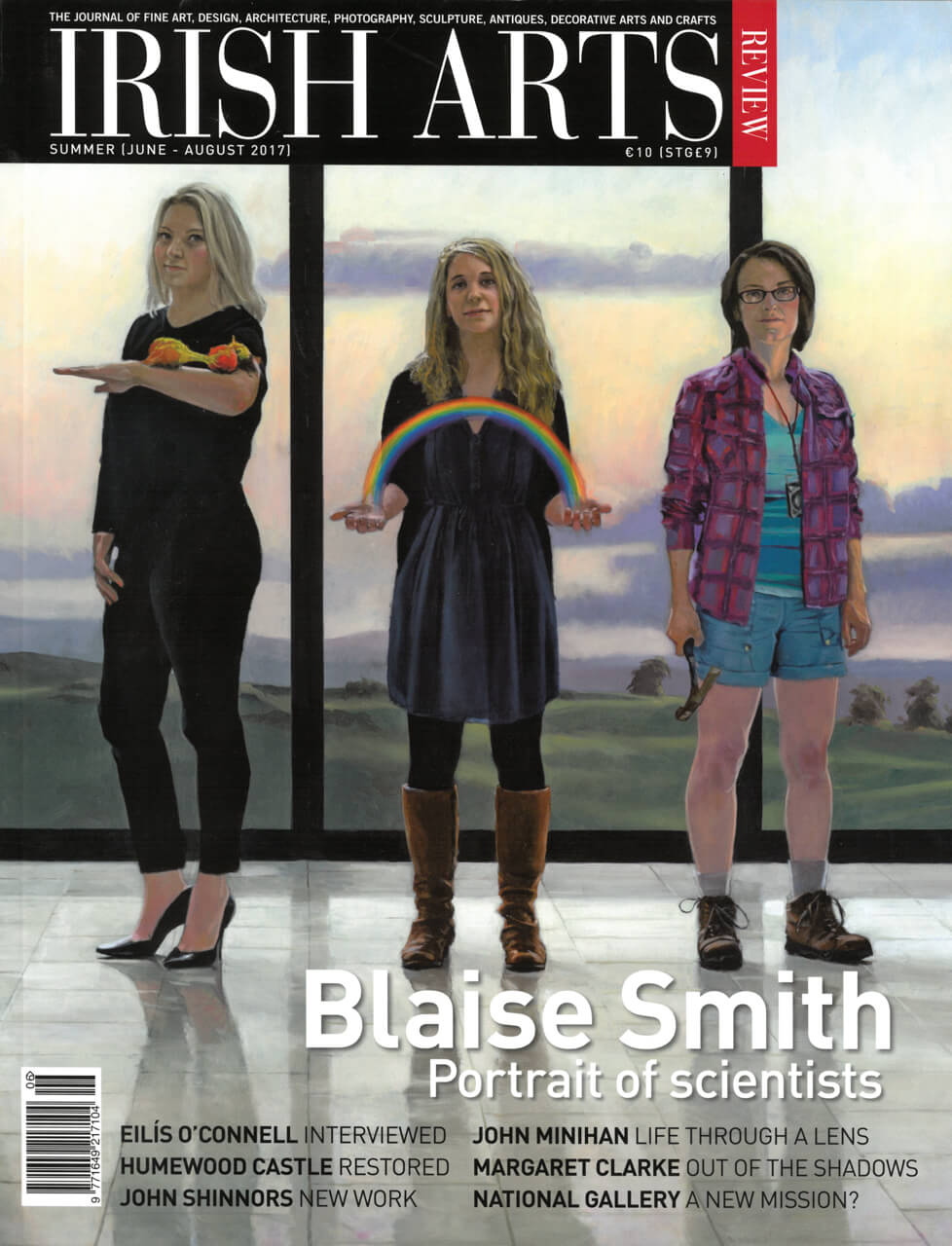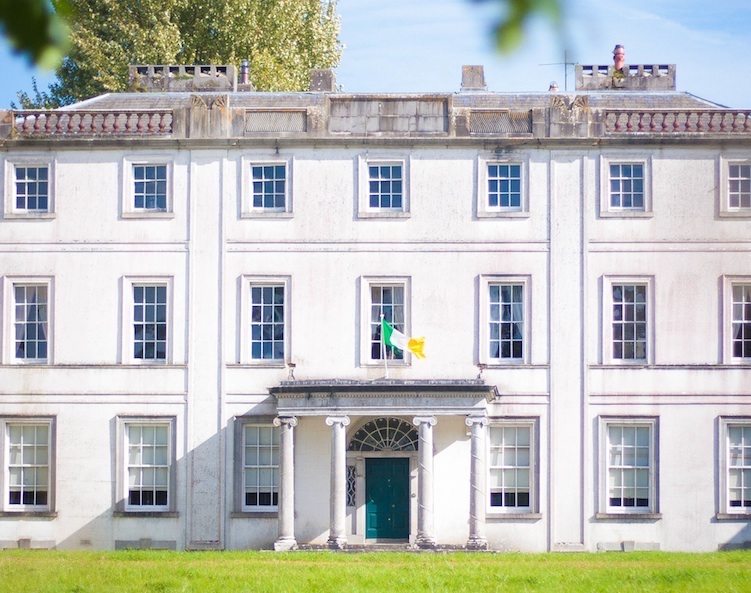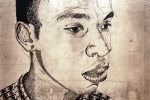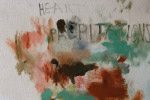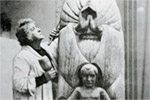
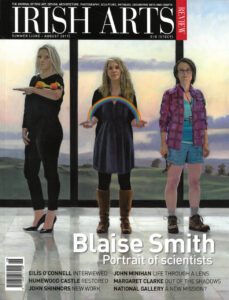
Peter Murray traces the extraordinary life and career of Clare Sheridan, artist, journalist and confidante of Charlie Chaplin
Well connected from birth, Clare Sheridan (née Frewen, 1885-1970) was a celebrated sculptor, writer and traveller, who spent much of her childhood and later years in Ireland. Her mother Clara came from a prominent New York family, and her grandfather Leonard Jerome was nicknamed ‘the King of Wall Street’. Her father, Moreton Frewen (1853-1924), of Innishannon House in Cork led a peripatetic life, moving from England to America, then to Ireland and finally back to England again. This restlessness was echoed in Clare Sheridan’s own life, which was spent constantly on the move. Her mother’s sister Jennie had married Randolph Churchill and thus Clare was a cousin to their son Winston Churchill. The family relationship between Clare Sheridan and her cousin Winston Churchill was crucial in the development of her career, both as artist and writer.
In her memoir, Nuda Veritas (the 1928 US edition is entitled Naked Truth), Clare Sheridan describes Innishannon House as ‘a mere square shooting lodge ‚Ķ comfortable but plain’. Her governess, ‘Mademoiselle’, attempted to look after her, but Clare was a tomboy. She and her brothers Peter and Hugh, and cousin Shane Leslie, went shooting woodcock and wild duck, accompanied by a parent or keeper. In Ireland, Moreton became a ‘Home Ruler’ and was, for a time, on the side of the tenants during the Land Wars, although this did not prevent the family from experiencing hostility. Moreton occupied his time writing on economic theory and setting up a fish hatchery, to breed salmon and rainbow trout. The enterprise proved ill-fated and the hatcheries were sabotaged.
To further her education, Clare was sent to the Convent of the Assumption in Auteuil, in Paris from where she announced to her family that she wished to convert to Catholicism. Her American mother observed that were she to do so, she might find it difficult to get married in England so Clare was removed from the convent and sent instead to Darmstadt, where she went to the opera twice a week and played ping-pong with German officers. A maid was sent to Darmstadt to fetch her home, and further attempts at conventional schooling were abandoned. However Innishannon House had a good library, and her father was a prolific author. His book The Economic Crisis, although concerned with international monetary theory, accurately described his own family finances. Clare read Ibsen and other authors, including AP Sinnett’s Growth of the Soul and Esoteric Buddhism. Sinnett was president of the Theosophical Society and Clare had known him since she was a child. She became absorbed in the concept of Karma.
Brought to London and dressed at some expense, Clare attended balls and parties and fell in love with a young stockbroker named Wilfred Sheridan. But her parents disapproved and she returned to Cork and commenced her first attempts at writing with a play called l’Ingénue. Years later (Naked Truth (Harpers 1928) p. 37) she described her first season at Dublin Castle: ‘I have never been unwilling to give Royalty its due. There is something pleasantly medieval in the authority of the head of a clan, of a tribe or of a state, but minor royalties have always seemed to me rather pathetic. Lord Dudley masquerading as the King, by royal sanction, provoked my sense of the ridiculous. No royalties were ever quite as royal. Aides-de-camp pervaded the Castle, upholding what they regarded as a Royal standard. They supervised the entertainment of the guests by day, but at night the real show began . . . Every night we sat down to a banquet, band accompanied, and when it was over and the ladies left the hall, each paused at the door to perform another curtsy. It was the seriousness of the performance that struck me as comic. To those same people across the water the Dudleys would have had no importance, but here in Ireland their English friends combined together to preserve the farce. . .’
They arrived penniless in Cannes. Clare was given fifty pounds by an old friend of her father’s. Her mother cried but they kept the money. They went to Monte Carlo, gambled, and won.
In 1904 Clare and her mother were in Malta, where her brother Peter was a midshipman on Lord Charles Beresford’s flagship, leading the Mediterranean fleet. Clare recalled dancing every night ‘with admirals and midshipmen’. The fleet left suddenly, and so did the Frewens. They arrived penniless in Cannes. Clare was given fifty pounds by an old friend of her father’s. Her mother cried but they kept the money. They went to Monte Carlo, gambled, and won. Then they continued on to Genoa, to meet up with the fleet again.
Meanwhile, Clare’s family had moved from Cork to England, her mother buying Brede Place, a 14th-century ruin on Edward Frewen’s estate in Sussex. Stephen Crane, author of The Red Badge of Courage, came to live in the partly restored house. Henry James was just four miles away, at Rye. Clare became friends with James, and also with the novelist George Moore. She began to write articles, and also a novel, showing chapters to both James and Moore. Moore described it as ‘charming’ and a ‘dear little book.’ In response, Clare flung the manuscript across the room, danced on it, kicked it, and finally put a match to it.
At Brede Place, Clare created a garden with flowers donated by her famous friends. The Duke of Connaught sent bamboo, Wilfred sent rose trees, George Moore sent fuchsias, while Kipling sent lavender and rosemary. But for her father, bankruptcy was impending: ‘In London we never knew when we entered the drawing-room whether bailiffs would be sitting there or not. Once when Peter and I returned from a walk and rang the door bell, it was answered by an unknown man. . .’ Fleeing these parlous economic conditions, Clare went to Capri, where she stayed in a house owned by Swedish psychiatrist Axel Munthe. She attributed to Munthe her initial introduction to Bolshevism. He advised her to gain independence from her mother through marriage, and so on her return to England in 1910 she and Wilfred Sheridan became engaged. At the wedding she refused to say the word ‘obey’, and the Canon was shocked by the irreverence of bride and groom. Clare settled in rural England with Wilfred, where they had two children, Margaret and Elizabeth. However in 1914 Elizabeth died in infancy. Clare became friendly with Mary Watts, widow of artist George Frederick Watts, who ran a nearby pottery and who encouraged her to sculpt a memorial to her deceased daughter. She enrolled in the modelling section of the Guildford Technical School, bringing the half completed clay memorial with her.
The following year, her son Richard was born, but a few days later her husband Wilfred was killed at the Battle of Loos. Stricken by this second loss, and the deaths of other close friends in WWI, Clare resolved to devote her life to sculpture. She went on to study, firstly in the studio of John Tweed and then with √âdouard Lantéri in South Kensington, absorbing through them the influence of Rodin, and receiving commissions to sculpt portraits of leading public figures, including a marble bust of Herbert Asquith for the Oxford Union (Fig 4). Other sitters included Hazel Lavery, HG Wells, Lord Birkenhead, Winston Churchill (Fig 5), Shane Leslie and Princess Patricia of Connaught. The Canadian War Museum bought her portrait of WWI air ace, William Avery Bishop. Sheridan also learned by watching Epstein at work.
Still in her early thirties, she was an unconventional figure in London society, with radical views echoing those of her father. In 1920, the Bolshevik, Lev Kamenev, leading a Russian delegation to London, invited her to Moscow, where she sculpted portraits of Dzerzhinsky, Trotsky and Lenin. The Bolsheviks were fascinated to have in their midst a cousin of Winston Churchill. However, back in England, Sheridan found herself under suspicion due to this closeness to the Russian revolutionaries so she decamped to America where an exhibition of her Russian portraits, held in New York, caused a sensation. On St Patrick’s Day she took her son Dick to see the Sinn Féin parade on Fifth Avenue but not long afterwards she heard that her family’s steward in Cork had been murdered. Several houses at Innishannon were burned at this time, including Cor Castle and Innishannon House.
As a writer, Clare sheridan was lively, humane and intolerant of hypocrisy
Around this time, Sheridan’s writing career began to take off with the publication of her memoir Russian Portraits, and she became a correspondent for The New York World. During the Irish Civil War, she interviewed both Rory O’Connor and Michael Collins, travelling with Collins and the Lord Mayor of Cork, Barry Egan, on a train to Dublin. Collins’s forces had been responsible for the burning of Innishannon House. ‘We had to’, he explained to Sheridan, ‘as a reprisal – but we shall pay compensation.’ Of Collins she later wrote: ‘He died of course, as Irish leaders generally die, betrayed, ambushed, out-numbered, murdered by the people he had tried to save.’ To interview Rory O’Connor, Sheridan made her way to the occupied Four Courts, and gained entrance, as correspondent for the New York World.
As a writer, Clare Sheridan was lively, humane and intolerant of hypocrisy. Her admiration for the United States is evident in My American Diary, in which she recounts her travels in 1921 in Mexico and California. As well as moving in elite circles, Dick Tobin (later American Minister to the Hague) organized for her to visit San Quentin Prison. She spent a day there, interviewing female prisoners. The women prisoners she described as ‘tremendous feminists’ and they spent much time discussing the Treaty of Versailles and its outcomes. In October she met Charlie Chaplin, who had read her memoir From Mayfair to Moscow and was keen to meet her. ‘He is not Bolshevik nor Communist, nor Revolutionary, as I had heard rumoured.’ They watched his latest film, The Kid, together at a private screening. At the time, Chaplin was living in Moorcrest, a house designed by Marie Russak Hotchener for the Krotona Theosophist Society in Hollywood. ‘The house is not his, but is rent, is Moorish and fantastic in design, the tortuous unsimplicity of which disturbs Charlie. But he loves the quiet of it and the isolation on a hill top with the panorama of the town extending for miles below to the sea.’
On Sheridan’s return to London in 1924, she managed to sell to the Russian embassy copies of her busts of the Russian leaders. She continued a restless life, criss-crossing Europe and America, spending time in Germany, at the League of Nations headquarters in Geneva, Athens and Constantinople, then attending the Lausanne conference. She undertook sculpture commissions in the United States, and the money earned, along with her income as a journalist – including interviewing Mussolini in Rome – helped to support her family. She packed all her belongings and son Dick onto a Russian steamer and headed to Odessa, then on to Istanbul, where Potemkin, the Russian consul, gave her a villa to live in. Although accused of spying for the Russians, and isolated from other western Europeans, Sheridan was on friendly terms with the Turkish President, Ismet Pasha, and the French High Commissioner, Louis Mougin. But the atmosphere was poisoned by accusations of espionage. Knowing war was coming, she considered returning to Russia, thinking that her son Dick would be safer there than in Britain, where he was likely to be conscripted. But instead they moved on to Algeria, a sojourn recounted in her 1936 book Arab Interlude, and marked by the tragic death of Dick.
During World War II, Sheridan did a second portrait of Winston Churchill while she lived at Brede Place. In the late 1940s, Sheridan lived at Oranmore in Co Galway. She also lived at the Spanish Arch in Galway city in a house that later became the first museum of the city. In later years, she lived at Allington Castle in Kent where she carved, from bog oak, a celebrated Madonna. From 1956 she lived at Belmont House, near Hastings from where she wrote To the Four Winds in 1957 and three years later she entered the Franciscan Order as a nun. Clare Sheridan died in 1970, aged 84 years and is buried in the churchyard of St George’s, Brede.
Peter Murray is co-editor of Art and Architecture of Ireland Volume V: Twentieth Century (Yale University Press 2014).
